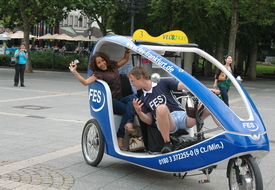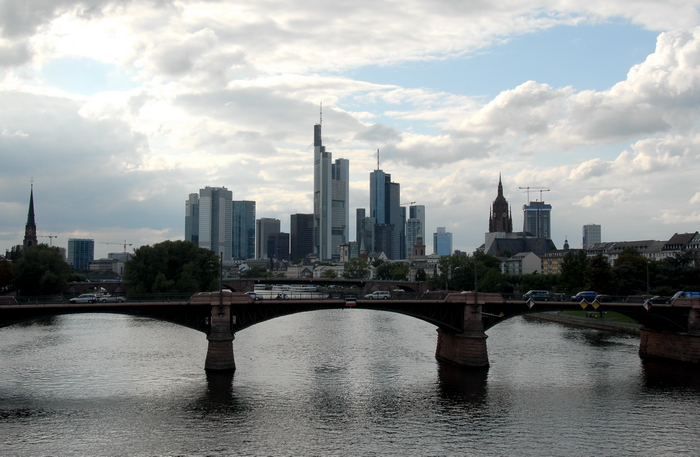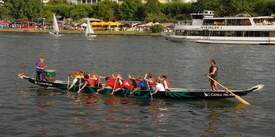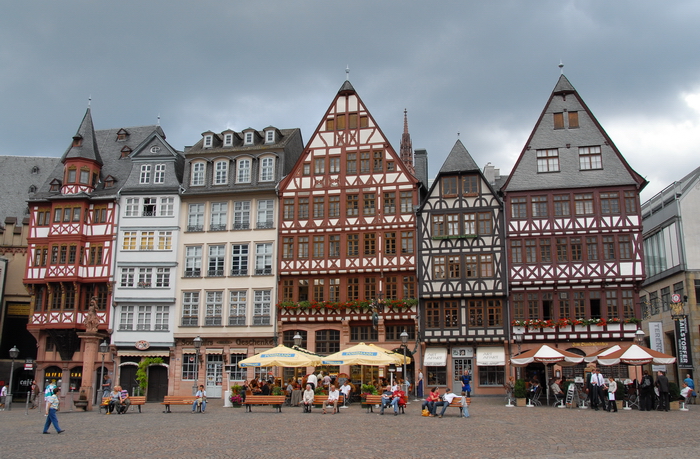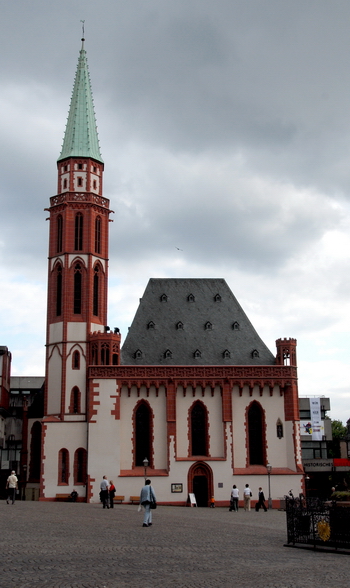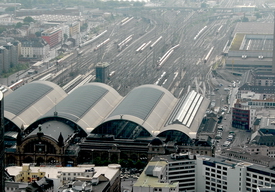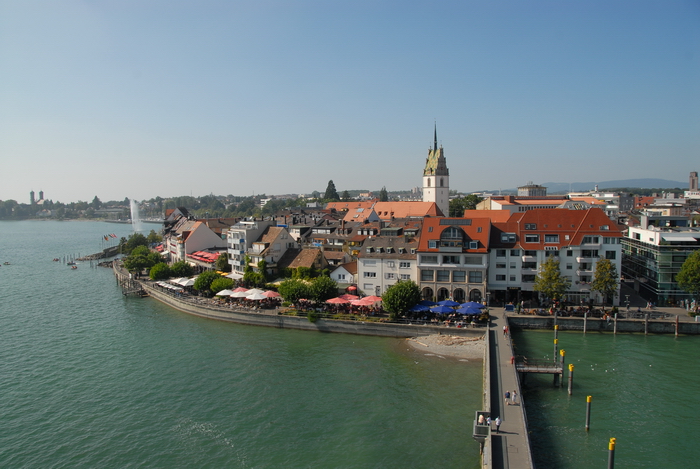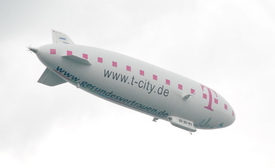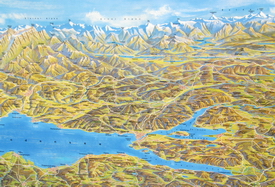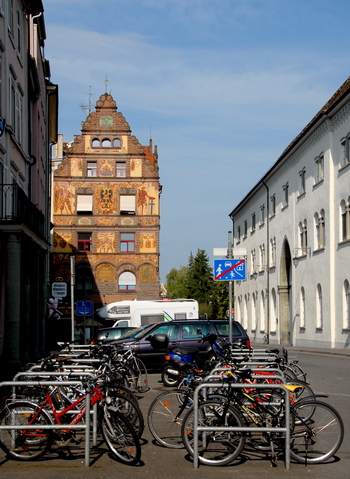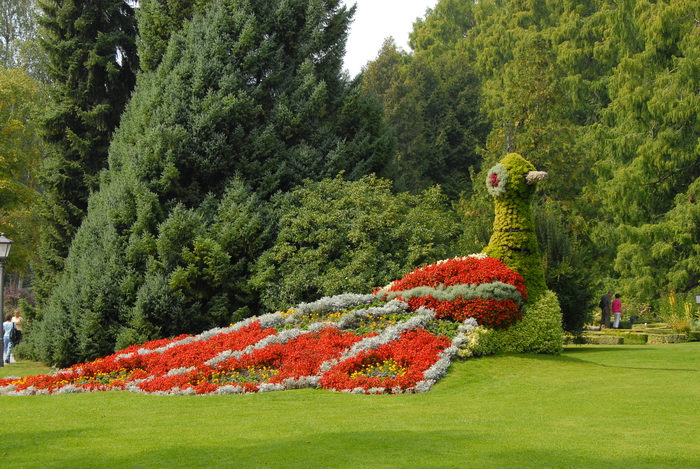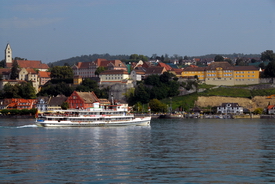Germany August 2008
This was a quick vacation visit with Nancy’s brother Ralph and his wife Margrit. Ralph and Margrit live in Hagen, about 40 miles from Cologne in West-Central Germany. However, Ralph has been working in Friedrichshafen (Fredrick’s harbor), a small town in the southern tip of the country. He is a contract programmer for ZF, the w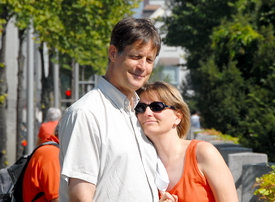 orld’s largest manufacturer of transmissions for cars and trucks. Every weekend he commutes by train. Of course the distance from Margrit, who has her own public relations business, adds complications in their relationship, but he likes his work and as a contractor is able to spend more time on vacation and long weekends in Hagen.
orld’s largest manufacturer of transmissions for cars and trucks. Every weekend he commutes by train. Of course the distance from Margrit, who has her own public relations business, adds complications in their relationship, but he likes his work and as a contractor is able to spend more time on vacation and long weekends in Hagen.
On this Labor Day weekend trip, we spent two nights in Frankfurt, two in Friedrichshafen, and nearly two days flying back and forth. But as you will see below we packed this time with a huge variety of activities and experiences.
Frankfurt
Our impressions of Frankfurt were very favorable. Instead of a beltway, a narrow park 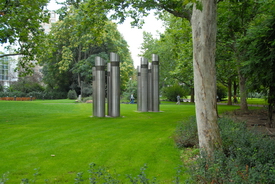
Parked in the shadow of the Opera House was this bicycle buggy offering a convenient way to see the city even when it rains? This bicycle driver had not only very strong legs but strong vocal cords to talk about the city. Nancy got this great shot:
Frankfurt is Germany’s largest financial center. The Banking Quarter is a huge banking and insurance sector with the tallest skyscrapers in Europe. Because these gigantic towers sit close to the Main River that cuts through the city, the publicists call it the Manhattan or Chicago of Germany.
The Frankfurt skyline has become dominated by tall modern office buildings and Frankfurt boasts the tallest two buildings in Europe. Frankfurt is also called the Paris of Germany because not only does it have a mix of old and modern buildings, but it has a large river, the Main (pronounced mine) River, lined with culture: museums and other such centers right in the middle of the city. A river adds character to a city as Paris and London prove. But wouldn’t it be nice if the publicists made up their mind on what to nickname Frankfurt.
The observation tower on the 56th floor of the Main Tower office building gives a full circle view of the cities mixture of the old and the new. The Main Tower’s elevator gave us an experience akin to rapture: its speedometer registered 7 meters/second (33 ft/second).
Another key element of the Banking Quarter is the Euro Management Center. This is where several hundred office workers administer the policies and procedures for the European Union’s currency. As you can see in the photo, the huge statue of the Euro symbol guards the Euro building.
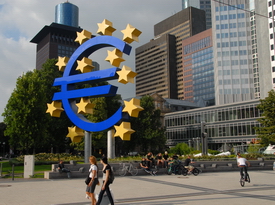
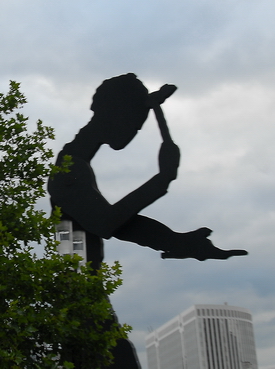 he is the biggest hammering man on the planet. And he is constantly slamming his hammer down, day and night. As he is planted on the sidewalk among the skyscrapers, he symbolizes hard work but because of the tall buildings, in most views he appears as a silhouette.
he is the biggest hammering man on the planet. And he is constantly slamming his hammer down, day and night. As he is planted on the sidewalk among the skyscrapers, he symbolizes hard work but because of the tall buildings, in most views he appears as a silhouette.
On our first walk to the River, we discovered a festival in full swing on both sides of the River. There were booths selling food, advertising technical schools, and selling crafts. Intermixed among these booths were large music stages with professional musicians. It reminded me of a State Fair, but without an admission fee.
The Main River adds nautical life to the City with many boats of all kinds and thousands of people watching them from the riverbank. We watched as the teams of rowers pulling their oars with great energy. It would be like the typical American river rowing club except that the boats sacrifice lightness and sleekness for cultural symbols. Each rowing boat had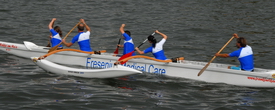
The number one tourist destination in Frankfurt is the Romer Square, also called Romerberg or the Historical City Center. “Romer” started as a large settlement of Romans in the 15th century. The main features of this Square are:
- The Ostzeila, a collection of houses stuck together and each built with a long of timber. The entire frame of each house is made of wood, which adds to the architectural fun.
2. The City Hall takes up a prominent place in the Square. It is still used today for government function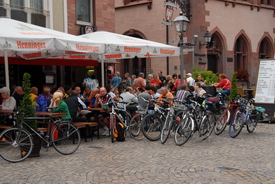
- St. Paul’s Lutheran Church stands very tall (in the photo on the right) in the Square and fits well with the Roman building style. It can be seen simultaneously with the Frankfurt Cathedral, which is more elegant but ornate.
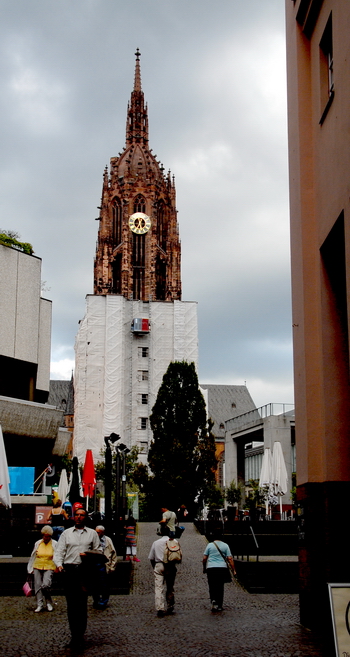
Unlike most German cities that required that builders preserve the historic character of all buildings after the great bombings of 1944, Frankfurt allowed new, modern buildings. This policy may have helped Frankfurt’s economy to flourish. None-the-less, many of the old buildings have been restored so that they appear as if they were built in the 13th through 18th centuries. It goes without saying that Frankfurt’s architecture is diverse and eclectic. If you look carefully at the photo on the right you can see Romerberg squeezed between the spires of the C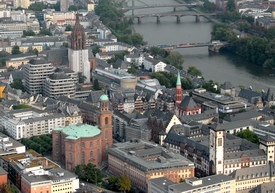
Did you know that Frankfurt is famous for its apple cider? The production of this slightly fermented cider began 1,200 years ago when grape vineyards fell on hard times. The business eventually led to a section of the city filled with restaurants and pubs featuring apple cider. The district is called Sachsenhausen (pronounced sexy house). We walked their streets too early as most of these apple entertainment facilities don’t open until 9pm. We were intrigued by one restaurant that advertises a dinner menu from medieval times.
Frankfurt has many other landmarks that we didn’t have enough time to explore. Another was the Goethehaus (Goethe’s house) where the famous poet was born. The cute little house has been restored and functions as a museum. Another historic piece of Frankfurt is its Jewish Sector. At one time it was a true ghetto because the Jews could not leave the neighborhood. Of course it was destroyed during the war, but has been authentically rebuilt.
Finally, the Frankfurt Rail Station is Germany’s busiest and one of the largest in Europe. Because of its centrality it serves as hub for huge volumes of passengers moving about Europe. It is like a giant airport with book shops and restaurants, but not a security guard in sight. It is from here that we left for the weekend lake experience.
Friedichshafen
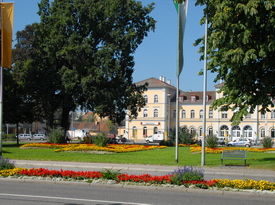
The German Bahn (rail system) whisked us from Frankfurt to the southern tip of Germany in about two and a half hours. The 250 mile trip included a change of trains in Ulm. The switch between trains demanded that we hurry with our luggage up and down several flights of stairs in only 6 minutes, but we made it both ways. On the return the train was packed with people returning home after their holiday. August is the traditional month for vacations in Europe.
Friedrichshafen (Frederick’s harbor),which is shown in the picture below, is a small lakeside town of 50,000 people bounded on the remaining sides by orchards, villages, and industries. Immediately across from the train and bus stations is the beautiful public square with bright colored flowers greeting any visitors, most of who arrive by train.
After a pleasant lunch with Ralph and Margrit, we took a long stroll on the wide lakeside walkway, which makes it convenient for boarding boats, having a snack or going to the well known Zeppelin Museum. As we strolled we ran across this elderly man operating an old fashioned puppet show. Simultaneously he controlled eight hand-carved puppets with dozens of strings. As you can see in the picture, the children were fascinated.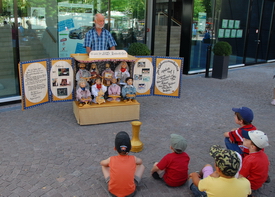
Zeppelin Museum
This little town is actually known as “Zeppelin City” because Mr. Zeppelin built the first blimps (dirigibles) and hard-shell airships here over 100 years ago. The very large Zeppelin Museum sits right across from where the public ferries dock. Incidentally, the Germans pronounced Zeppelin like trampoline but with a “tsep” sound beginning the word instead of a “tramp.” Zeppelins were used to bomb London in WWI and for years they transported people back and forth across the Atlantic. After the infamous Hindenburg blew up in New Jersey, the first age of the Zeppelins ended.
Close to the center of town is a Zeppelin airship port where these huge bomb-shaped balloons take off. In the past 10 years Zeppelin tours of the lake are a favorite way to see Lake Constance. You may not put such a trip in your next European itinerary, however, because the cost is about $500. This includes luxury seating in a totally quiet, peaceful glide around the lake. Most such airships are now made in this little town and the Zeppelin company is owned by Daimler, the company one that makes Mercedes cars.
Lake Constance (Bodensee)
Perhaps the most popular resort area in Germany, the Bodensee (which means grounded body of water) not only serves millions of sight seers, but it provides drinking water for much of Central Europe. Its nearly 200 miles of shoreline are shared with Switzerland and Austria. The map, looking South, shows how close the lake is to the Swiss Alps. About 40 passenger boats provide transportation from village to village and two ferry boats take cars, trucks and buses back and forth between Germany and Switzerland. The Rhine River flows through it, but we never got to that part of the Lake. Friedrichshafen is the principle port on the north side of the lake and Konstanz is the largest port on the south side.
Konstanz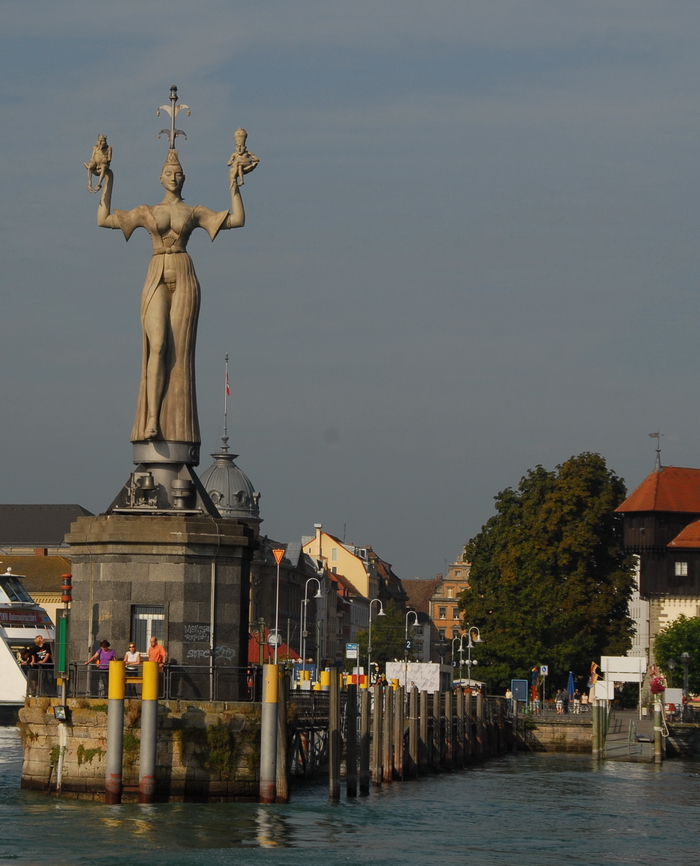
The city of Konstanz (Constance in English) is only steps from the Swiss border, but probably more people arrive by boat. We took the sleek catamaran service from Friedrichshafen to Konstanz. As we entered the harbor we were greeted with a giant stone statue of a woman. I found it difficult to keep my eyes off of the statue, not only because she was scantily clad, or that she revolved slowly round and round, or because in one hand she holds a doll-size naked pope and in the other a doll-size naked king, but because of her imposing posture and self-confident glare. She is the spitting image of Sara Palin, John McCain’s running mate. The photograph may reveal some of this resemblance.
The name of this woman ensconced in stone is Imperia. She was not a historical figure but a symbol of the major role that female “courtesans” (escorts) played in the making the city historically famous. In the early 1400s, the Church located their administrative center here. In was in the Council Building behind Imperia that the Pope was elected, and major battles, both verbal and physical, carried on over issues of church reform.
We arrived in Constance about 9:30 in the morning and the streets were quiet and peaceful. A few people drank their morning coffee on the tables in the cobblestone streets.
Not surprisingly the city of Constance has cathedrals and quaint buildings. The building in this photo on the left was an inn in 1400 and remains a hotel. Its beautiful wall paintings caught my fascination. Fortunately little villages like Constance escaped the devastation to ancient buildings that the world wars imposed upon the cities. In the photo note the number of bicycles; this is quite different from an American hotel parking lot.
Next we took a slow passenger boat to Mainau Island famous for a huge botanical garden. A duke bought the island 150 years ago and in the past few decades his descendents turned it into a nonprofit public retreat. I cannot remember walking through such a large garden with so many blooming flowers. This was the end of summer, and the middle of spring would have had even more flowers in bloom. Here is a picture of a giant peacock made with growing flowers and evergreens. Most of the flowers grew in natural settings and obviously receive the tender care of master gardeners. The magnificent trees also appeared healthy though hundreds of years old.
Perhaps the highlight of the Gardens was the Butterfly House. Nancy and I have visited a number of butterfly houses, but this is by far the largest and provides the most natural habitat we have seen. Hundreds if not thousands of butterflies flew among leaves, bushes, orchids, and hibiscuses. Here are pictures from the Gardens. The big butterfly in the second row is an Atlas Atticus butterfly with a wingspan of about 5 to 6 inches. It reminds me of a South American blanket. It has just emerged from a huge cocoon, which we could still see. Other gigantic cocoons hung from the branches waiting their turn for Mother Nature to go into labor. Nancy appears in the first photo below, but she took most of the beautiful pictures in this set.
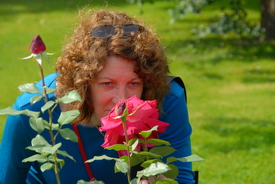 |
 |
 |
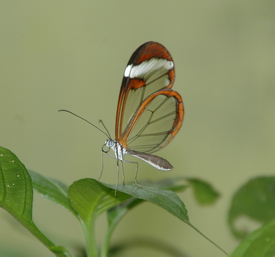 |
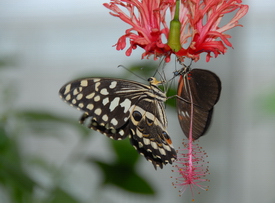 |
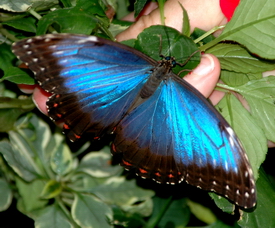 |
The last stop was the little village of Meersburg on the north side of the Lake. As you can see in the picture the village was built on a cliff.
The big cliff-top building in the picture is a large winery. Vineyards are plentiful on the Lakeside slopes and Meersburg became the center of this business.
As we left Meersburg I snapped this photo of resort-type houses along the shore. Note that these chalet-like structures are huge and apparently house a large number of families. The culture of the Alps has undoubtedly seeped down into the southern Germany plains. 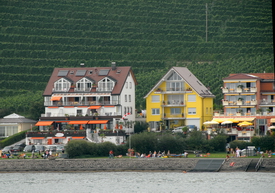
Notes on German Culture
About five million people live in the Frankfurt metro area. The economy is robust and the city has the lowest unemployment rate of any German city. Homeless panhandlers are rare, but even they are well dressed. Remarkably the police are nearly invisible compared to the United States and terrorist-ridden countries like Israel.
In my compilation of statistics on compassion-related indicators of social well-being, Germany is in the top third of the 20 wealthiest countries. By way of comparison, the USA is in the bottom two or three countries. This index represents the extent to which national policies are humanitarian. For example, the USA has the highest infant mortality rate and the largest percent of incarcerations of all 20 of the wealthiest countries. Germany, on the other hand, is well below average on these statistical indicators.
When we arrived in Germany I had not analyzed these statistics, so I was not expecting to see anything dramatically different from the United States. But what I observed even in a matter of 4 days was a much more humane culture. There was almost no evidence of extreme differences in wealth, no crowds of poor people on the streets, and very few obese or unhealthy looking people. We did see racial diversity, especially middle-eastern people, however only 9% of the country is ethnic/racial minority. Germany’s most challenging social accomplishment in recent times is the integration of Eastern Germany with Western Germany, which was analogous to ethnic integration.
It does not take long for an American to learn that Germans tend to be American-friendly. Upon learning we were Americans, one taxi driver immediately said “John Wayne, I like him.” And then he put in a good word for the governor of California, whose name I’ve forgotten. In contrast to France and most Asian countries, almost everyone speaks enough English to carry on a short conversation. The school system requires at least 6, maybe 8, years of the study of English, which not surprisingly makes a difference.
Conservation or green culture is a major concern for Germans, which is reflected in tiny cars and widespread use of bicycles, trains, trams, and buses. This kind of behavior undoubtedly is influenced by their gasoline that costs about $9 per gallon. They also feel quite happy with small cars because they can be parked in tiny pla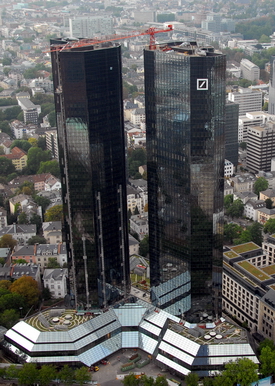
Ads and articles encouraging energy conservation seem much more plentiful in Germany than the United States, as is the use of solar panels on buildings. In Frankfurt the talk was about their very visible “green towers.” Since then, I have discovered green tower projects in NYC and Tokyo. Deutsche Bank has nearly completed construction of the Green Towers (see photo on right).
The goal of the green towers was to reduce energy use and CO2 emissions by 50 percent by replacing the water, lighting and air-conditioning systems. Now it appears they can achieve an even higher percentage. The towers use the following: a gas-powered buffered heating and cooling system; radiant heating and cooling; increased the u values in glazing; windows that open; solar water heating; and grey water recycling (from sinks and showers).
Security at Frankfurt’s airport is even tougher than America, but outside the airport, security or police are nowhere in sight. This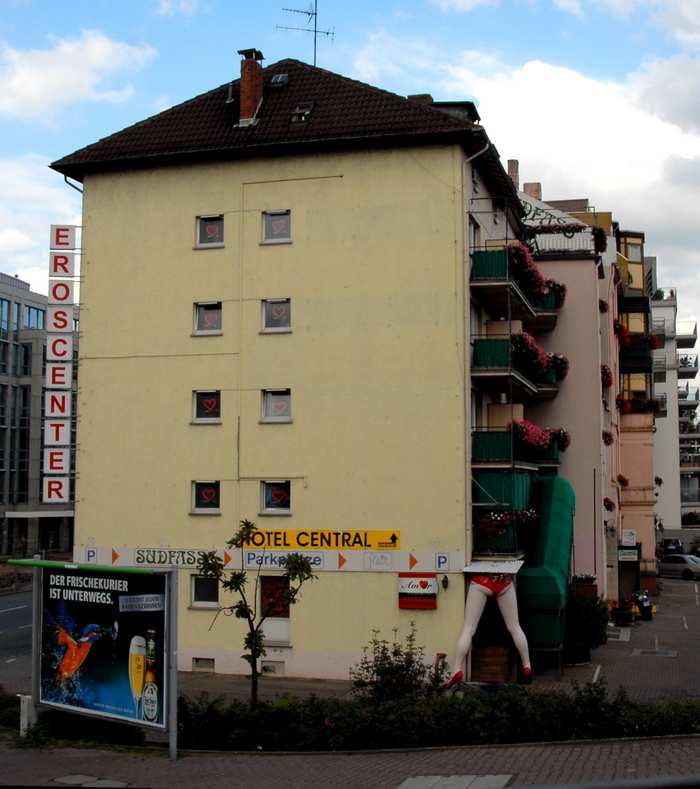
Drinking of beer and wine becomes legal at age 16 rather than 21, and the police and judges are lenient about possession of marijuana. The European model is to communication clear expectations to young people about individual responsibility rather than the American model, which is to try to get conformity by punishment for rule-breaking.
Something about the German system works because the people largely behave even though law enforcement does not hover around. We were told in most parts of the big city of Frankfurt, one could walk the streets or the city parks at night without worry. I was also impressed at how conscientious the Germany people were about putting all waste in waste containers. In contrast, some Americans consider it un-American to be so conforming.
Families play a very central role in Germany. Families do a lot of things together including children and adults just sitting around together talking. We saw a lot of families bicycling together on the weekend. Buses and boats provided space for bicycles. We saw several instances of a parent on a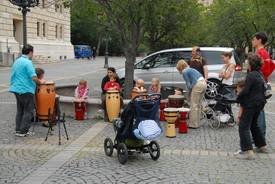
The photo on the right was taken in the park in Frankfurt where multi-racial families were playing drums and the children were getting drum lessons. I was impressed how integrated families were having fun together.
Humor
I don’t know if it is true, but I have been told that there are no German comedians, and that they are challenged when it comes to humor.
Do any of you Germans have an opinion on this score?
